Irrigation is important to ensure crops receive water at the correct stages during growth. Irrigation means watering crops by bringing water through pipes, canals, sprinklers, or other man-made sources, rather than relying solely on rainfall. Places with low or seasonal rainfall cannot sustain agriculture without irrigation.
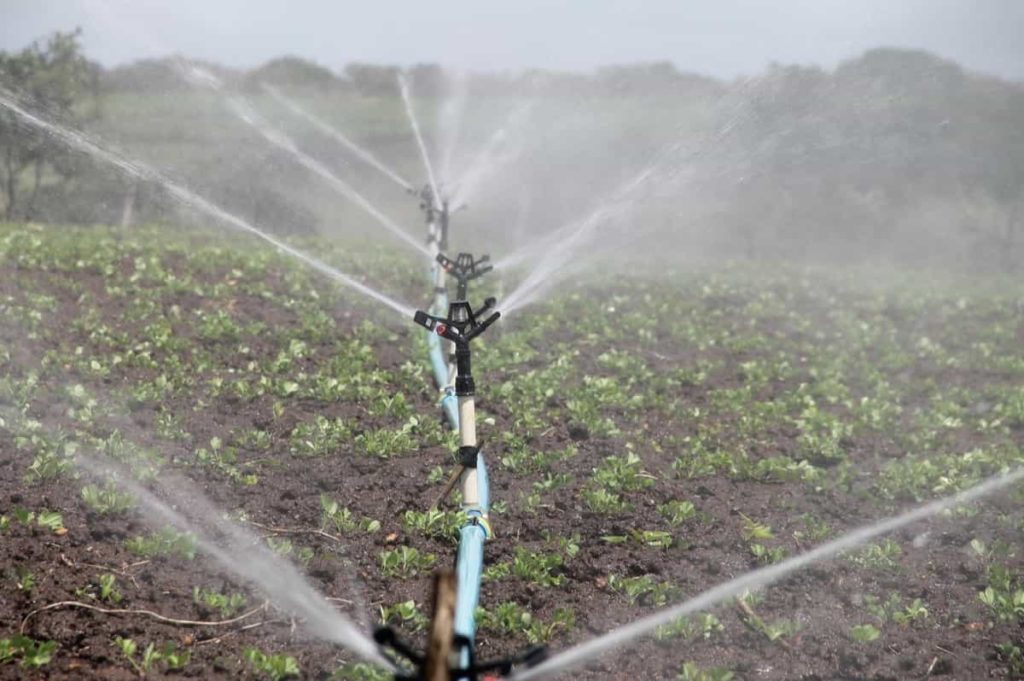
Plants and crops require water for their proper growth and development. Water is an essential element for the existence of plants and humans, and other living organisms. A proper process called irrigation is followed to supply water to the crops. There are many ways to irrigate crops, and all practices ensure good crop health. The irrigation process ensures that the crops receive water evenly for uniform growth. Irrigation should be done properly as it has adverse effects on the crops. Let’s see the methods, types, and key rules of effective irrigation management.
16 key rules for effective irrigation management
Basic points need to be considered for effective irrigation planning
Irrigation water comes from groundwater sources, such as reservoirs, springs, and wells, or surface water sources, such as rivers, ponds, or lakes. An adequate supply of water is very important for plant growth. Irrigation is the only way our farmers can continue to store and use water properly.
Not only this, but with proper irrigation facilities, our farmers will be able to spend less time in the fields and more time learning new skills, personal development, and agricultural forums. Irrigation is also essential for the healthy growth of the crop to achieve a good yield. Nutrients dissolved in water reach every part of the plant. Water also protects the crop from both cold and hot air. Below are the basic points for effective irrigation management;
- Land suitability
- Effective rainfall
- Decide when to irrigate (depends on the soil, crop, and weather conditions)
- How much water does the crop need
- Choose the most suitable irrigation method
- Irrigation water quality
Key rules for principles of irrigation water management
Farmers have used various methods to irrigate fields for hundreds of thousands of years. Crops are irrigated in some ways: flooding the entire field, running water between rows of plants, spraying water through large sprinklers, or releasing water onto the plants through holes in pipes. Letting water drop on plants through holes in pipes, known as drip irrigation, is considered one of the most efficient irrigation methods. Drip irrigation focuses water on the plant itself. When sprayed through a sprinkler, water can become evaporate in the air.
The basic principles of irrigation scheduling from a soil water perspective are:
1. Soil moisture – Sites for soil monitoring should be selected most representative of the field. Its purpose is to limit water in heavy soils and overwater light soils. For precision irrigation where water can be controlled in small areas within the field, more monitors will be needed, and monitoring of both improved and poorer soils will be required.
2. Root zone depth – The depth of the root zone is the zone where most of the root structure is found. It varies with different potato varieties, but as a general rule, the roots will extend 18 inches below the seed pod.
3. Effective irrigation – Effective irrigation is the amount of water that reaches the root zone and is available to the plant. Some irrigation water (actual irrigation) is lost due to runoff, evaporation, or deep percolation.
4. Daily water consumption – The plant’s daily water consumption depends on the plant’s growth stage and the day’s environmental conditions. Environmental conditions that affect daily water use are air temperature, relative humidity, wind, and solar radiation.
In case you missed it: Drip Irrigation for Vegetables – a Full Guide

Different irrigation methods for reducing production cost
Modern irrigation methods vary widely but fall into different categories: surface irrigation, furrow irrigation, sprinkler, and drip irrigation.
Surface Irrigation System
Surface, or flood irrigation systems, are humans’ earliest irrigation methods. A surface irrigation system floods a cultivated field with runoff, usually from a water source such as a canal. Fields are graded on a gradual slope away from the water source (or may even be on a terrace), so water flows across the area. Crops are usually planted in parallel beds, so water flows easily downwards between the roots of the plants.
Furrow irrigation
It differs from flood irrigation, except that the irrigation system is achieved by using pipes or hoses to direct the water away from the initial source. Many crops are irrigated from furrows and pits between ridges on which crops are planted. Lateral water is introduced into each furrow by cutting a small dike of soil, thus opening a gap. When the water in each furrow reaches the desired level, the supply is cut off by closing the deck again. However, it may be justified for high-value crops like vegetables.
Sprinkler Irrigation
Sprinkler irrigation systems use a pressurized water system to apply water through sprinkler heads. The pressure is obtained from the pump. Sprinkler irrigation systems can be fixed or portable systems. In addition, many different types of nozzles and sprinkler heads can be used. Therefore, it provides flexibility in coverage and spray pattern.
The sprinkler method is the simplest and most effective irrigation system. Water can be placed where needed, and flow rates can be regulated more precisely than in other systems. The sprinkler can also be used effectively on smooth and ungraded rough and hilly terrain. There are many types of sprinklers, some like lawn sprinklers. Units can be portable, permanent, or semi-permanent.
Drip Irrigation
Drip irrigation can be defined as a method in which water is slowly dripped through a pipe system from above or below the soil surface to the roots of plants. It is also called micro-irrigation, through which water and soil nutrients can be conserved. A setup of valves, tubes, pipes, and emitters is used for drip irrigation. The best thing about drip irrigation is that the valves and pumps can be operated manually and automatically with the help of a controller.
Sub-irrigation
This method raises the water table to moisten the soil below the plant roots. Then, the water is pumped to the field in ditches and allowed to percolate into the soil to maintain the required groundwater level to feed the plant roots. Compared to the flood method, irrigation water is significantly reduced, but sub-irrigation requires water of good quality and low salinity. Nevertheless, it is effective for delicate plants like Strawberries, small fruits, and vegetables because it keeps the tops of the plants dry and helps prevent damage by rotting or fungi.
In case you missed it: Lift Irrigation Farming in India, Importance of Lift Irrigation
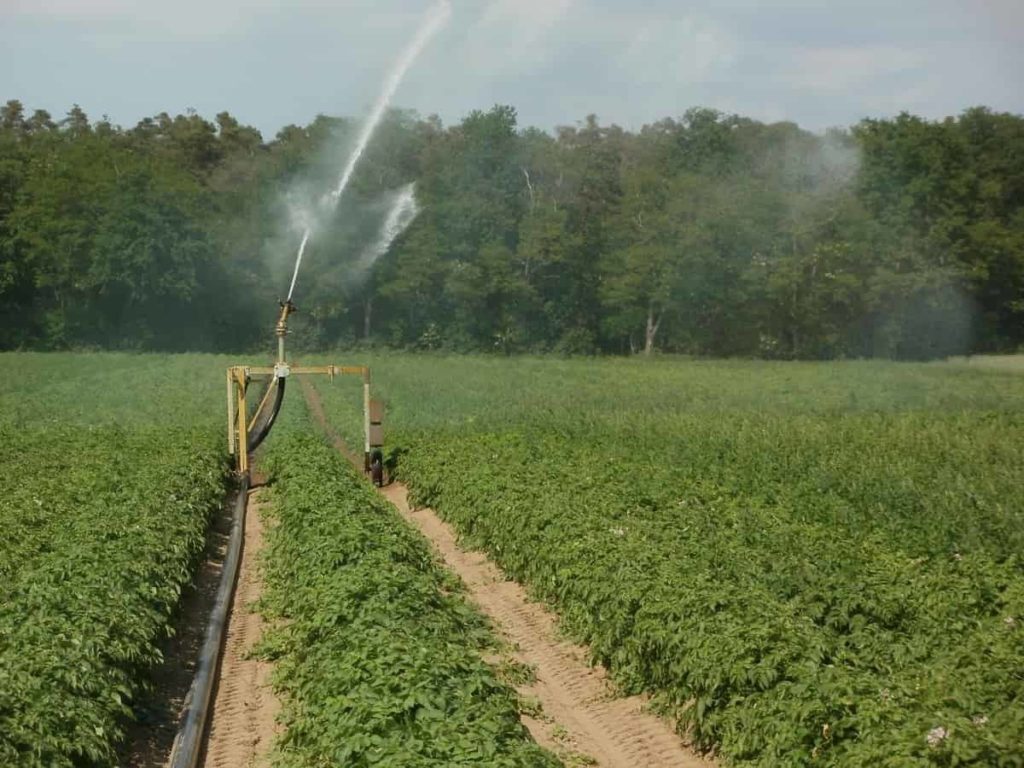
Effective sources of irrigation for more production
The different types of irrigation systems adopted for supplying water to agricultural lands are:
- Wells– There are two types of wells: dug wells and tube wells. In a dug well, water is collected from the aquifer. Tube wells can extract water from deep strata.
- Canals– This is a vast and extensive irrigation system. Canals mainly receive water from one or more reservoirs or rivers in this system.
- River Lift System– The lift system is more reasonable in areas where canal flow is irregular due to insufficient reservoir discharge.
- Tanks– These are small storage reservoirs that intercept and store runoff from small catchment areas.
Factors to consider in choosing an irrigation method
Compatibility with other farm operations
The irrigation system for a crop field must be designed and operated in a manner that does not make the use of other operations or other equipment difficult or impossible. You need a long and wide field if you plan to use large machinery. Small implements or animal-powered farming equipment are more suitable for smaller farms and permanent irrigation facilities.
Water supply
Water quality and quantity determine irrigation performance. Water demand for crops is constant during the growing season. Therefore, a water supply with a relatively low discharge is best used in irrigation systems that involve frequent applications. The water quality factor also influences decisions. A supply of poor quality water (without plant nutrients) should be used more frequently and in more significant quantities than good quality water.
Economic feasibility
Choosing an irrigation method or system is an important economic decision. Some pressurized systems have higher capital and operating costs but can save less labor and water. Other systems are relatively less expensive to build and operate but are more labor intensive. Some are limited by soil type or field topography. Before you make your choice, consider maintenance costs and the maintenance life expectancy. Also, consider energy, water, depreciation, land preparation, maintenance, labor, and taxes.
Topographical features
Topography is one of the major factors affecting irrigation, especially surface irrigation. The slope of the plain and its uniformity are the most important topographical factors. Surface irrigation systems require uniform terrain. Furthermore, the location and elevation of water supplies depend on field boundaries, the area, and layout of fields, access to roads, utility lines (gas, electric, water, etc.), and migratory herds, whether wild or domestic.
Soil properties
Consider soil moisture holding capacity, intake rate, and depth. These are important criteria in selecting an irrigation method. Sandy soils have higher bulk density and lower soil moisture storage capacity than loamy soils. It means that fields with sandy soils may require completely different irrigation methods than those with deep clay soils. Sandy soils require more frequent, smaller water applications, while loamy soils can be irrigated less frequently and more deeply.
Crop characteristics
Irrigation systems create different environmental conditions such as moisture, temperature, and soil aeration. The yield of many crops can be affected as much as how the water supply is used. Crops have high economic value and allow the application of more capital-intensive practices.
Key rules for the importance of irrigation supplies
- Agriculture is often severely affected by irregular, insufficient, or uncertain rainfall. A proper irrigation system can secure uninterrupted agriculture.
- The productivity of irrigated land is higher than non-irrigated land. Everywhere in the developing world, crop yields are consistently higher in irrigated areas than in rainfed areas.
- Seeds cannot germinate in dry soil because moisture is essential for seed germination. More than one crop in a year is possible through irrigation. It will increase production and productivity.
- In many parts of India, two or three crops are grown in a year with an irrigation facility. It is possible to supply the required amount of hydrogen and oxygen, which is important for the proper growth of plant roots.
- A plant can absorb mineral nutrients from irrigated soil. Thus, irrigation is essential for the normal growth of the plant. It is possible to bring more land under cultivation through irrigation.
- Inadequate rainfall can also cause drought and famine. Irrigation can play a protective role during drought and famine.
- Irrigation contributes to economic growth and poverty reduction. As income and employment are closely linked to production and irrigation increases, incomes in rural areas increase substantially.
In case you missed it: Drip Irrigation Cost per Acre in India – A Full Guide
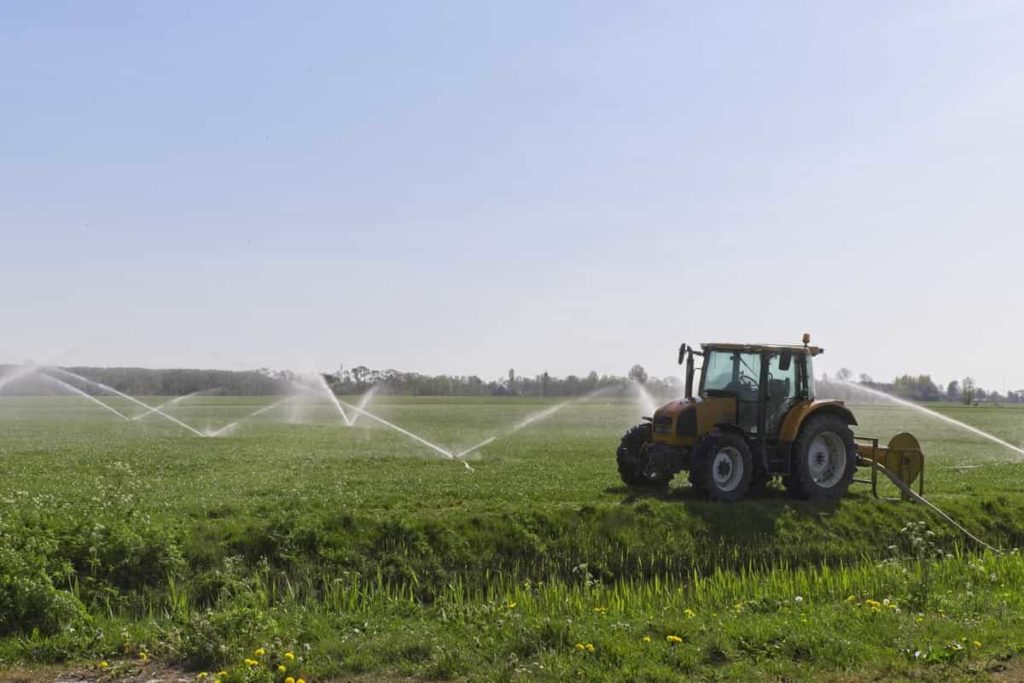
Most efficient way to irrigate your crops
Application of irrigation water where the entire soil surface is covered by pond water. Early humans may have used this “low-tech” method of irrigating crops — collecting water in a bucket and pouring it over the fields. Today, it is still one of the most popular crop irrigation methods. Irrigation helps grow crops, maintain the landscape, and regenerate disturbed soils in dry areas and during periods of below-average rainfall.
Irrigation has other uses in crop production, including frost protection, weed control in grain fields, and soil stabilization. Irrigation is the artificial water supply to agricultural land. More than half of the world’s farmers practice it because they need more water for their crops than is available from rainfall. Irrigation projects should also allow for excess water discharge.
Along with modern irrigation and drainage systems, the use of fertilizers, and mechanization, agricultural productivity has increased tremendously. Irrigation itself is the artificial delivery of moisture for the benefit of growing crops. Farming without irrigation is considered rain-fed and is often referred to as dryland farming. Therefore, irrigation systems are simply a farmer’s water transport from its source to cultivated fields.
Low-cost irrigation techniques for more production
One of the most benefits of an irrigation system is protecting your yard, plants, and trees from stagnant water and drought. A well-designed system ensures that your grass and plants get the right water.
Benefits of irrigation
- Good for low rainfall areas.
- Improves soil fertility.
- Generate hydroelectricity.
- Improves the standard of living of farmers.
- Prevent weeds.
- Stop deforestation and famine.
Key rules for irrigation scheduling for more production
Irrigation scheduling is calculating the soil water budget to determine when irrigation is needed and the amount of irrigation water to apply. Important components of irrigation scheduling include:
- Amount of rainfall
- Amount of potential evapotranspiration
- Wilting point soil water content
- Allowable crop depletion factor
- Crop rooting depth
- Planting time
It is the process by which an irrigator determines the time and amount of water applied to a crop or pasture. To avoid over- or under-watering, it is important to know how much water is available to the plant and how efficiently it can use it. Methods available to measure this include:
- Plant observation
- Soil feel and appearance
- Soil moisture monitoring devices
- Available water from weather data
Effective objectives of irrigation management
The primary objectives of irrigation management or irrigation, in general, are to promote proper plant growth and maintain proper moisture levels for the soil. Another objective can be seen as ensuring that backup insurance is in place when there is a short period of drought, as this can sustain the farm sufficiently when the water level is low. Another reason is to cool the atmosphere and soil, which is an ideal environment for plants.
Furthermore, regular irrigation can dilute any harsh chemicals or harmful salts in the soil. Finally, with irrigation, you can reduce the risks of soil piping that can increase soil erosion from unnatural groundwater flow. Soil piping is an alternative method of irrigation. Still, it can jeopardize farming results and the stability of any surrounding buildings with movement when soil moisture levels are too high. And cause the building to move.
Main objectives of irrigation supply
- Ensure adequate moisture for plant growth.
- Provide crop insurance against short-term drought.
- Wash or dilute harmful salt and soil chemicals.
- Reduce the risks of soil piping.
Key rules to increase the overall efficiency of an irrigation system
Understanding rainfall rates, reducing run time-based on irrigation head arc and pressure, raising/leveling heads, using proper nozzles, and measuring soil moisture can significantly improve irrigation efficiency. It helps. Also, keep records of irrigation reductions to gauge how effective this strategy is over time. Drip irrigation is an efficient method of irrigating crops and has the advantage of less evaporation than other irrigation methods; it is the most common type of “micro-irrigation.”
The yield of many crops can be affected by how much water supplied is used. Irrigation systems create environmental conditions like moisture, temperature, and soil aeration. They affect the plant in different ways by wetting different parts of the plant, causing various undesirable results like leaf burn, fruit deformity, crown rot, etc. Deep-rooted crops are more amenable to low-frequency, high-application-rate systems than shallow-rooted crops.
In case you missed it: Solar Drip Irrigation System Benefits, Model
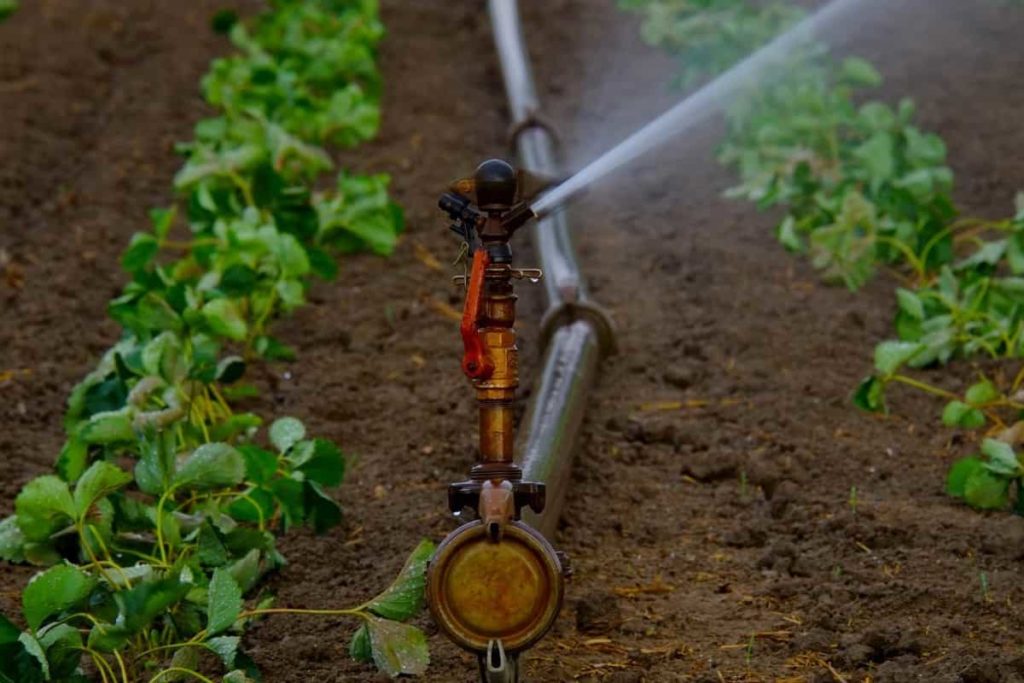
Key rules for the best time to water plants
Morning watering is better than evening watering because the plant has time to dry before sunset. Water sits in the soil, around roots, and on plants at night, promoting rot, fungal growth, and pests. Irrigation water management is the process of timing and managing the use of irrigation water to meet crop water needs without wasting water, energy, and plant nutrients or depleting soil resources.
Key factors in selecting the best irrigation method
- Compatibility with other form functions
- Economic feasibility
- Topographical features
- Soil properties
- Water supply
- Crop characteristics
- Social effects
- External influences
Key rules/tips for minimizing irrigation costs while maintaining yields and profits
Apply only water that will increase yield or profit – Tracking daily water transpiration, known as evapotranspiration (ET), and rainfall allow irrigators to apply the necessary water to replace water loss. An irrigation schedule will provide maximum yield with minimum requirements.
Use large irrigation applications – To make the best use of irrigation water, provide four or five days’ worth of crop water use per application, usually 1 to 1.25 inches at peak water use. These large irrigation applications reduce water lost through evaporation in the crop canopy, on residues, and at the soil surface by approximately 0.1 inches per application, regardless of the amount of irrigation water applied, making effective water available to the crop.
Increases the amount of a producer making two applications of 0.5 inches delivering 0.8 inches of effective water, compared to a producer making one application of 1.0 inches delivering 0.9 inches of effective water. As a result, center pivot irrigators that apply water faster than it penetrates the ground are forced to use smaller applications (less than 0.5 inches) to avoid irrigation runoff.
Use the least expensive energy source available – Choosing the most cost-effective energy source available has the potential for immediate and long-term cost savings. If available at a reasonable installation cost, three-phase electricity is a low-cost source when considering energy, equipment, and maintenance costs. If electrical installation costs are prohibitive, consider propane/natural gas over a diesel-fuel-powered system.
Landscaping – A final consideration for reducing irrigation water costs focuses on the areas where you are watering. You have many options for reducing water use by replacing plants. Landscaping can be achieved with a particularly low irrigation requirement, as native and drought-tolerant plants require very little water outside the rainfall allowance. You can also practice temporary irrigation with some plants. In some climates, you can find plants that will only need irrigation for 3-5 years until they are well established in the new ecosystem.
Most effective method of irrigation management
- Drip irrigation is an efficient method to water many different plants.
- It is an ideal method of watering clay soils because the water is applied slowly, allowing the soil to absorb the water and prevent runoff.
- In drip, trickle irrigation, developed in Israel, a perforated plastic pipe is laid on the ground. The holes are designed to release controlled water near the plant roots. This method reduces water loss due to evaporation and seepage deep below the root surface. It is mainly used in areas where water supply is limited.
In case you missed it: Crops Suitable for Drip Irrigation, Types of Drip Irrigation
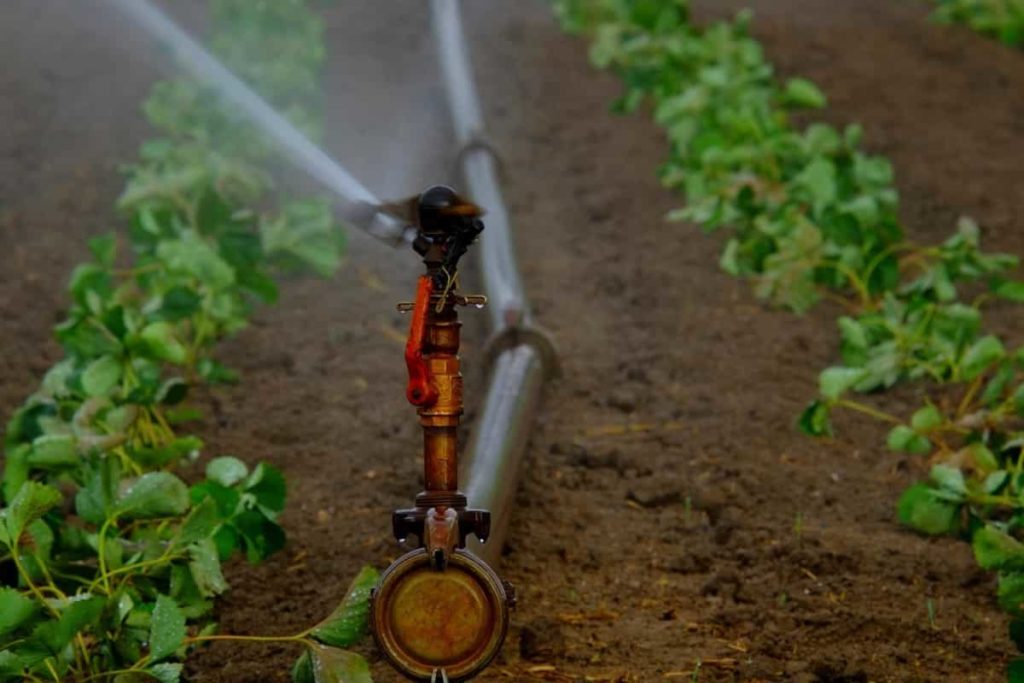
Techniques to improve irrigation efficiency
These are collectively called High-Efficiency Irrigation Systems (HEISs) that use pipes to transport water from the source to the point of use. In drip or trickle irrigation, water is delivered to individual plants through droplets through small emitters. Understanding the rainfall rate or how much water is applied to a given area is important. It can theoretically be calculated based on how many gallons/minute a head applies, head spacing, design (square vs. triangular), and arc rotation.
It will give you a ballpark value, but an additional step would be to verify the actual rain rate by performing a catch-can test. Understanding the rainfall rate for any given irrigation run time is especially important when scheduling irrigation based on making up for water deficits through evapotranspiration (ET). Realize that the water pressure is high near the pump station and will decrease as you move further away. Your rainfall rate will be closest to the pumping station with hydraulic rotors.
If all the rotors run simultaneously, there can be considerable pressure loss far away from the pumping station. It can be verified by pressure gauges attached to quick couplers – one close to the pump station and the other away from it. After the system is started and under maximum load, return with a flashlight, and record the average pressure over ten minutes. Irrigation times for heads near the pump station can be adjusted downward, depending on the pressure difference recorded.
Maintain uniformity of efficient distribution as much as possible. Unfortunately, no irrigation system works with 100% even distribution, and most irrigation auditors believe that a good number of shooting for is around 80%. To irrigate dry areas adequately, some areas would be flooded by up to 20%. Therefore, to reduce excess water consumption, improve the distribution uniformity as much as possible.
Conclusion
Irrigation systems are an important component of modern farm management that improve crop quality and yield. One of the biggest benefits of having an irrigation system is that although the design and installation can be expensive up front, it shouldn’t require much maintenance once installed. The only real cost you have after installation is your water bill, but you are now using your water more efficiently. In addition, an irrigation system is a long-term investment for your yard, saving you money over time. Above are the key rules for irrigation management for increasing production.
- How to Make Houseplants Bushy: Effective Tips and Ideas
- Innovative Strategies for Boosting Coconut Pollination and Yield
- Pollination Strategies for Maximum Pumpkin Yield
- The Complete Guide to Chicken Fattening: Strategies for Maximum Growth
- Natural Solutions for Tulip Problems: 100% Effective Remedies for Leaf and Bulb-Related Issues
- Revolutionizing Citrus Preservation: Towards a Healthier, Greener Future
- Natural Solutions for Peony Leaf and Flower Problems: 100% Effective Remedies
- Maximizing Profits with Avocado Contract Farming in India: A Comprehensive Guide
- Natural Solutions for Hydrangea Problems: 100% Effective Remedies for Leaf and Flowers
- The Ultimate Guide to Choosing the Perfect Foliage Friend: Bringing Life Indoors
- From Sunlight to Sustainability: 15 Ways to Use Solar Technology in Agriculture
- The Ultimate Guide to Dong Tao Chicken: Exploring from History to Raising
- The Eco-Friendly Makeover: How to Convert Your Unused Swimming Pool into a Fish Pond
- Mastering the Art of Delaware Chicken Farming: Essentials for Healthy Backyard Flocks
- 20 Best Homemade Fertilizers for Money Plant: DIY Recipes and Application Methods
- How to Craft a Comprehensive Free-Range Chicken Farming Business Plan
- Brighten Your Flock: Raising Easter Egger Chickens for Beauty and Bounty
- How to Optimize Your Poultry Egg Farm Business Plan with These Strategies
- Subsidy for Spirulina Cultivation: How Indian Government Schemes Encouraging Spirulina Farmers
- Ultimate Guide to Raising Dominique Chickens: Breeding, Feeding, Egg-Production, and Care
- Mastering the Art of Raising Jersey Giant Chickens: Care, Feeding, and More
- Ultimate Guide to Raising Legbar Chickens: Breeding, Farming Practices, Diet, Egg-Production
- How to Raise Welsummer Chickens: A Comprehensive Guide for Beginners
- How to Protect Indoor Plants in Winter: A Comprehensive Guide
- Ultimate Guide to Grow Bag Gardening: Tips, Tricks, and Planting Ideas for Urban Gardeners
- Guide to Lotus Cultivation: How to Propagate, Plant, Grow, Care, Cost, and Profit
- Agriculture Drone Subsidy Scheme: Government Kisan Subsidy, License, and How to Apply Online
- Ultimate Guide to Raising Araucana Chickens: Breed Profile, Farming Economics, Diet, and Care
- Bringing Hydroponics to Classroom: Importance, Benefits of Learning for School Students
- Ultimate Guide to Raising Polish Chickens: Breed Profile, Farming Economics, Diet, and Care
- Ultimate Guide to Raising Australorp Chickens: Profile, Farming Economics, Egg Production, Diet, and Care
- Silkie Chicken Farming: Raising Practices, Varieties, Egg Production, Diet, and Care
- Sussex Chicken Farming: Raising Practices, Varieties, Egg Production, Diet and Care
- Homemade Feed Formulations for Livestock: Discover Cost-effective Starter to Finisher Feed Recipes
- 20 Best Pig Weight Gain Supplements: Top Swine Weight Gain Formulas
- Ultimate Guide to Elderberry Farming: Propagation, Planting, Yield, Cost, and Profit